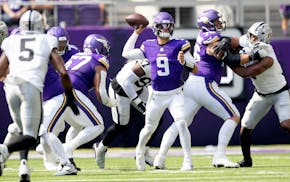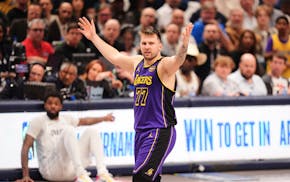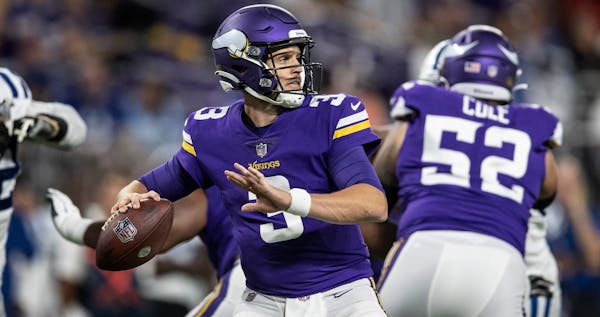Call it the "tush push," the "lumbar lunge," the "coccyx crush" or the world's least-musical mosh pit.
Call the modern quarterback sneak whatever you want. Then call it off.
The "brotherly shove" is not a real football play, dumbs down the sport, erases potentially spectacular plays and forces officials to make difficult game-deciding calls.
On Saturday in Cincinnati, the Vikings were in the midst of a thrilling-if-uneven overtime game with the Bengals. They faced third-and-1 at the Cincinnati 42. The game would be decided in the next two plays, when Vikings quarterback Nick Mullens barely moved while being pushed by wide receiver Brandon Powell.
If the tush push didn't exist, the Vikings either would have run a traditional quarterback sneak or a real offensive play. Given that Mullens is not large or mobile, Vikings coach Kevin O'Connell probably would have called for a power run or a play-action pass.
When he did that earlier in the game, the result was a deft play fake and pass from Mullens to Ty Chandler for a big gain. You know, one of those plays highlighting all of the aspects that make football great: planning, precision, sleight of hand, athletic ability and situational awareness.
Instead, the two plays that could determine the outcome of the Vikings' season required none of the above.
O'Connell called for two consecutive tush pushes — quarterback sneaks aided by a teammate or teammates pushing the quarterback from behind. It failed twice.
Once we're done debating whether Powell, one of the smallest players on the roster, should have been the push person — and he shouldn't have, and here ends the debate — we should acknowledge that the tush push is an unimaginative, ugly and problematic play.
The NFL is in the entertainment business. The tush push is a dull and unimaginative play, the result of which often asks officials standing dozens of yards away from the ball to guess where it should be marked, after they pull a ton of football players off the prone quarterback.
Congratulations to the Philadelphia Eagles for using the play so brilliantly, but this is not football. The NFL has adopted the worst part of rugby.
In an era when offensive play calling is innovative and there are more athletic quarterbacks than ever before, key offensive plays are being decided by whether the center or nose tackle ate the bigger breakfast.
Hating the tush push is not the same as letting O'Connell off the hook.
His rationale for using Powell in the backfield was that keeping Powell and the rest of the skill-position players on the field without substituting kept the Bengals from substituting their bulky run-defense personnel.
That would make more sense if O'Connell didn't have Powell stand behind Mullens. Powell's presence allowed an extra defensive back to crowd the line of scrimmage, and Powell lacks the bulk to propel Mullens.
Also, as we've seen with Kirk Cousins and Mullens, the play works best if your quarterback is a powerful athlete, like Eagles quarterback Jalen Hurts. Cousins and Mullens are lean pocket passers. Hurts can probably leg press as much as those two combined.
My advice to O'Connell: If you're going to use the power quarterback sneak, line up your most powerful players in the backfield behind your quarterback. Josh Oliver and C.J. Ham could probably toss Mullens over the line of scrimmage. (The "Nick flick"?)
Better yet, allow your best players to decide the game. Hand the ball to Chandler, who rushed for 132 yards and displayed the ability to twist for extra yards after contact. Not only would Chandler have had a better chance of getting a first down, but handing it to him would also create the possibility that he would pop through the line of scrimmage for a big gain.
And remember: The point of a drive is not to make as many first downs as possible. It's to score. Chandler might have won the game with a third- or fourth-down carry.
Better yet, the Vikings could have faked to Chandler and allowed Mullens to throw to one of three excellent receivers — Justin Jefferson, T.J. Hockensen or Jordan Addison.
Such a play not only could have won the game, but it would have looked like real football, not bad rugby.

Souhan: Vikings picked a good year to not need to pick a quarterback
Souhan: What should the Vikings do with the No. 24 pick - keep it or trade it?
Souhan: Wild scorers look slick but lack grease in Game 1

Souhan: Timberwolves embarrassed the Lakers? Don't be surprised. You were warned.


